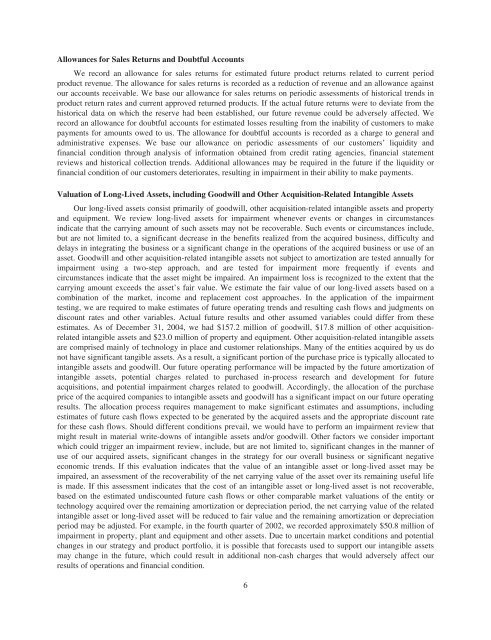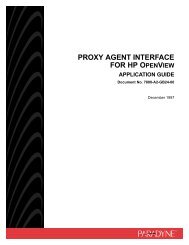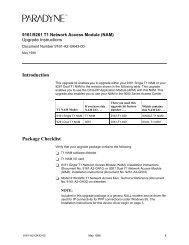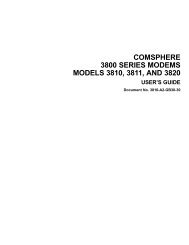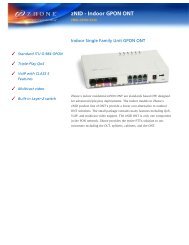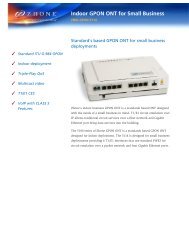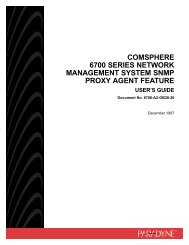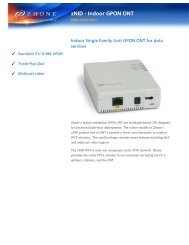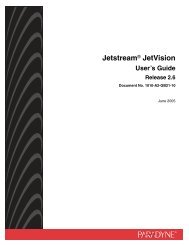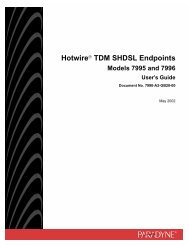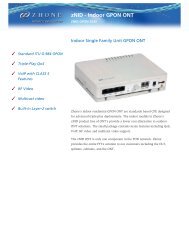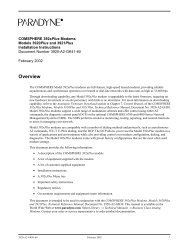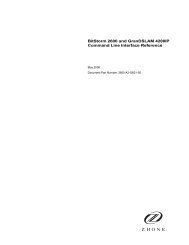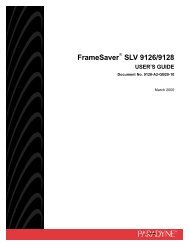Zhone Technologies Annual Report 2004
Zhone Technologies Annual Report 2004
Zhone Technologies Annual Report 2004
Create successful ePaper yourself
Turn your PDF publications into a flip-book with our unique Google optimized e-Paper software.
Allowances for Sales Returns and Doubtful Accounts<br />
We record an allowance for sales returns for estimated future product returns related to current period<br />
product revenue. The allowance for sales returns is recorded as a reduction of revenue and an allowance against<br />
our accounts receivable. We base our allowance for sales returns on periodic assessments of historical trends in<br />
product return rates and current approved returned products. If the actual future returns were to deviate from the<br />
historical data on which the reserve had been established, our future revenue could be adversely affected. We<br />
record an allowance for doubtful accounts for estimated losses resulting from the inability of customers to make<br />
payments for amounts owed to us. The allowance for doubtful accounts is recorded as a charge to general and<br />
administrative expenses. We base our allowance on periodic assessments of our customers’ liquidity and<br />
financial condition through analysis of information obtained from credit rating agencies, financial statement<br />
reviews and historical collection trends. Additional allowances may be required in the future if the liquidity or<br />
financial condition of our customers deteriorates, resulting in impairment in their ability to make payments.<br />
Valuation of Long-Lived Assets, including Goodwill and Other Acquisition-Related Intangible Assets<br />
Our long-lived assets consist primarily of goodwill, other acquisition-related intangible assets and property<br />
and equipment. We review long-lived assets for impairment whenever events or changes in circumstances<br />
indicate that the carrying amount of such assets may not be recoverable. Such events or circumstances include,<br />
but are not limited to, a significant decrease in the benefits realized from the acquired business, difficulty and<br />
delays in integrating the business or a significant change in the operations of the acquired business or use of an<br />
asset. Goodwill and other acquisition-related intangible assets not subject to amortization are tested annually for<br />
impairment using a two-step approach, and are tested for impairment more frequently if events and<br />
circumstances indicate that the asset might be impaired. An impairment loss is recognized to the extent that the<br />
carrying amount exceeds the asset’s fair value. We estimate the fair value of our long-lived assets based on a<br />
combination of the market, income and replacement cost approaches. In the application of the impairment<br />
testing, we are required to make estimates of future operating trends and resulting cash flows and judgments on<br />
discount rates and other variables. Actual future results and other assumed variables could differ from these<br />
estimates. As of December 31, <strong>2004</strong>, we had $157.2 million of goodwill, $17.8 million of other acquisitionrelated<br />
intangible assets and $23.0 million of property and equipment. Other acquisition-related intangible assets<br />
are comprised mainly of technology in place and customer relationships. Many of the entities acquired by us do<br />
not have significant tangible assets. As a result, a significant portion of the purchase price is typically allocated to<br />
intangible assets and goodwill. Our future operating performance will be impacted by the future amortization of<br />
intangible assets, potential charges related to purchased in-process research and development for future<br />
acquisitions, and potential impairment charges related to goodwill. Accordingly, the allocation of the purchase<br />
price of the acquired companies to intangible assets and goodwill has a significant impact on our future operating<br />
results. The allocation process requires management to make significant estimates and assumptions, including<br />
estimates of future cash flows expected to be generated by the acquired assets and the appropriate discount rate<br />
for these cash flows. Should different conditions prevail, we would have to perform an impairment review that<br />
might result in material write-downs of intangible assets and/or goodwill. Other factors we consider important<br />
which could trigger an impairment review, include, but are not limited to, significant changes in the manner of<br />
use of our acquired assets, significant changes in the strategy for our overall business or significant negative<br />
economic trends. If this evaluation indicates that the value of an intangible asset or long-lived asset may be<br />
impaired, an assessment of the recoverability of the net carrying value of the asset over its remaining useful life<br />
is made. If this assessment indicates that the cost of an intangible asset or long-lived asset is not recoverable,<br />
based on the estimated undiscounted future cash flows or other comparable market valuations of the entity or<br />
technology acquired over the remaining amortization or depreciation period, the net carrying value of the related<br />
intangible asset or long-lived asset will be reduced to fair value and the remaining amortization or depreciation<br />
period may be adjusted. For example, in the fourth quarter of 2002, we recorded approximately $50.8 million of<br />
impairment in property, plant and equipment and other assets. Due to uncertain market conditions and potential<br />
changes in our strategy and product portfolio, it is possible that forecasts used to support our intangible assets<br />
may change in the future, which could result in additional non-cash charges that would adversely affect our<br />
results of operations and financial condition.<br />
6


